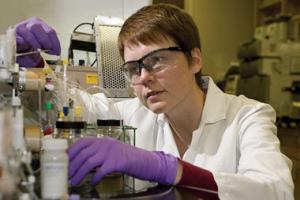Nuclear forensicsSpecialized ORNL team uses nuclear forensics to solve mysteries, safeguard materials
From the Manhattan Project in the 1940s to the High Flux Isotope Reactor’s 50th anniversary and its selection as an American Nuclear Society Nuclear Historic Landmark, the Department of Energy’s Oak Ridge National Laboratory (ORNL) has been the preeminent destination for nuclear R&D. A group of nuclear detectives at ORNL) takes on tough challenges, from detecting illicit uranium using isotopic “fingerprints” to investigating presidential assassination conspiracies.

Pursuing expertise in nuclear forensics // Source: tamu.edu
“A very big capability at Oak Ridge exists for nuclear analytics, all the way from helping commercial production of nuclear power to making sure the world’s nuclear materials are properly accounted for,” said ORNL’s Joseph Giaquinto, leader of the Nuclear Analytical Chemistry and Isotopics Laboratories, or NACIL. “My group is a specialized analytical group. We focus in the nuclear arena, from nuclear fuels R&D to nuclear forensics and safeguarding nonproliferation.”
ORNL says that from the Manhattan Project in the 1940s to the High Flux Isotope Reactor’s 50th anniversary and its selection as an American Nuclear Society Nuclear Historic Landmark, ORNL has been the preeminent destination for nuclear R&D.
Now NACIL researchers are bringing attention once again to ORNL’s nuclear capabilities. Equipped with the world’s best elemental mass spectrometers, superb cleanrooms and unmatched experience, the ORNL scientists are in high demand.
For instance, within the NACIL group are the analytical laboratories which were the first to be approved for as a network analytical laboratory for the United Nation’s International Atomic Energy Agency (IAEA), assisting the Atoms for Peace organization’s goal of safeguarding nuclear nonproliferation with global tests to detect illicit uranium enrichment activity.
In 2011 ORNL invested in its nuclear analytical chemistry group, converting the Mouse House, an underused facility that once held the national lab’s groundbreaking genetics program, into the state-of-the-art Ultra-Trace Forensics Science Facility. Over the last two years the U.S. Department of State provided NACIL investments totaling more than $1.5 million to replace aging mass spectrometers with state-of-the-art instruments with capabilities unmatched in sensitivity and precision. Under Giaquinto’s six-year leadership, the group’s funding for nuclear forensics work has skyrocketed, increasing nearly 10-fold over previous years.
With growing project requests coming from myriad sources like the State Department, the U.S. Department of Homeland Security, NASA and IAEA, the ORNL scientists are applying seventy-plus years of nuclear know-how to tackle some of the world’s most pressing nuclear security problems.
